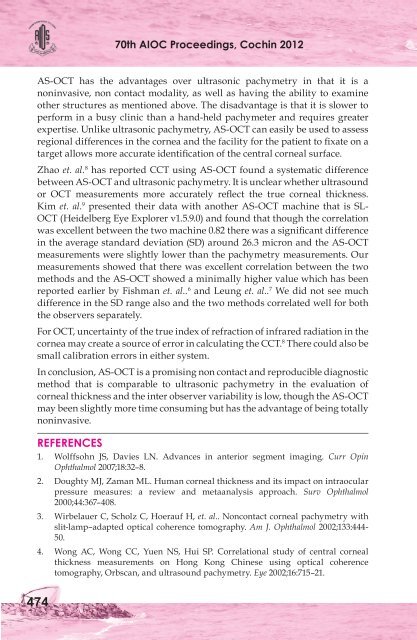Comprehensive Ophthalmology Free Papers - aioseducation
Comprehensive Ophthalmology Free Papers - aioseducation
Comprehensive Ophthalmology Free Papers - aioseducation
You also want an ePaper? Increase the reach of your titles
YUMPU automatically turns print PDFs into web optimized ePapers that Google loves.
70th AIOC Proceedings, Cochin 2012<br />
AS-OCT has the advantages over ultrasonic pachymetry in that it is a<br />
noninvasive, non contact modality, as well as having the ability to examine<br />
other structures as mentioned above. The disadvantage is that it is slower to<br />
perform in a busy clinic than a hand-held pachymeter and requires greater<br />
expertise. Unlike ultrasonic pachymetry, AS-OCT can easily be used to assess<br />
regional differences in the cornea and the facility for the patient to fixate on a<br />
target allows more accurate identification of the central corneal surface.<br />
Zhao et. al. 8 has reported CCT using AS-OCT found a systematic difference<br />
between AS-OCT and ultrasonic pachymetry. It is unclear whether ultrasound<br />
or OCT measurements more accurately reflect the true corneal thickness.<br />
Kim et. al. 9 presented their data with another AS-OCT machine that is SL-<br />
OCT (Heidelberg Eye Explorer v1.5.9.0) and found that though the correlation<br />
was excellent between the two machine 0.82 there was a significant difference<br />
in the average standard deviation (SD) around 26.3 micron and the AS-OCT<br />
measurements were slightly lower than the pachymetry measurements. Our<br />
measurements showed that there was excellent correlation between the two<br />
methods and the AS-OCT showed a minimally higher value which has been<br />
reported earlier by Fishman et. al.. 6 and Leung et. al.. 7 We did not see much<br />
difference in the SD range also and the two methods correlated well for both<br />
the observers separately.<br />
For OCT, uncertainty of the true index of refraction of infrared radiation in the<br />
cornea may create a source of error in calculating the CCT. 8 There could also be<br />
small calibration errors in either system.<br />
In conclusion, AS-OCT is a promising non contact and reproducible diagnostic<br />
method that is comparable to ultrasonic pachymetry in the evaluation of<br />
corneal thickness and the inter observer variability is low, though the AS-OCT<br />
may been slightly more time consuming but has the advantage of being totally<br />
noninvasive.<br />
REFERENCES<br />
1. Wolffsohn JS, Davies LN. Advances in anterior segment imaging. Curr Opin<br />
Ophthalmol 2007;18:32–8.<br />
2. Doughty MJ, Zaman ML. Human corneal thickness and its impact on intraocular<br />
pressure measures: a review and metaanalysis approach. Surv Ophthalmol<br />
2000;44:367–408.<br />
3. Wirbelauer C, Scholz C, Hoerauf H, et. al.. Noncontact corneal pachymetry with<br />
slit-lamp–adapted optical coherence tomography. Am J. Ophthalmol 2002;133:444-<br />
50.<br />
4. Wong AC, Wong CC, Yuen NS, Hui SP. Correlational study of central corneal<br />
thickness measurements on Hong Kong Chinese using optical coherence<br />
tomography, Orbscan, and ultrasound pachymetry. Eye 2002;16:715–21.<br />
474

















